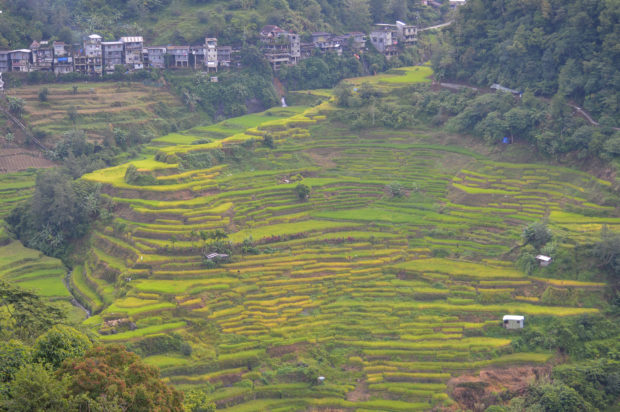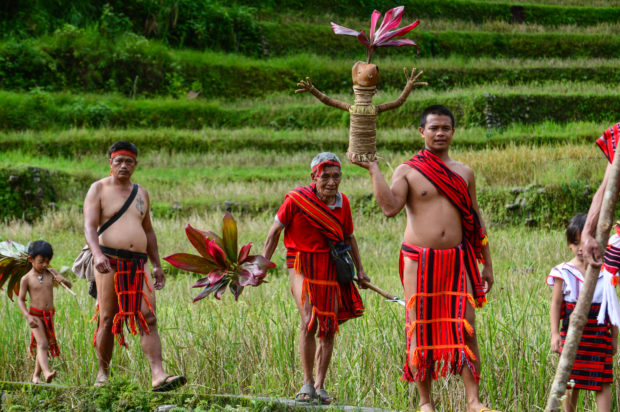On the edge: Saving Ifugao rice terraces

KEEPERS OF ANCIENT CULTURE Although modern Ifugaos no longer wear G-strings and carry spears except for rituals, they continue to find relevance in the cultural foundations that have kept the rice terraces thriving for generations. The task of protecting the terraces is now in the hands of young Ifugaos. —PHOTOS BY KARLSTON LAPNITEN
BANAUE, Ifugao, Philippines — As fog creeps up the contours of the mountainside at daybreak, Miguel Tumucal fixes his gaze on the stair-shaped edges of the vast farmland.
For decades, the 60-year-old elder has witnessed how the cultural landscape in his village of Amganad in Banaue town and elsewhere in Ifugao has evolved from one generation to another.
Amganad is home to families of farmers who produce the heirloom rice “tinawon” (literally “once a year”) from the ascending rows of terraces.
Ifugao’s terraces are listed as a World Heritage Site, but these have also been on the endangered list of the United Nations Educational, Scientific and Cultural Organization (Unesco), citing the dwindling workforce and other social and environmental factors, including changes in management of watershed forests.
Tumucal and other villagers in Amganad still practice the indigenous system of farm management called “chawa” to sustain production of the homegrown rice variety.
Under chawa, a farmer enters into a verbal agreement with the owner of the land to cultivate it for a season. The harvest is to be divided equally in terms of rice bundles.
“Irrigation is the life of tinawon. Less irrigation means low harvest, a bane to farmers,” Tumucal told the Inquirer.
Rice terraces are strategically placed lower than the age-old “muyong,” the communal forest that serves as watershed from where irrigation water flows.
Changing weather patterns
Tumucal says the farmers are now beset by irrigation problems and they must preserve the muyong as it is also the source of materials for wood carving and basketry, a major industry in Ifugao.
“We’re experiencing a depleting source of water over the course of time. Even the weather has slightly changed patterns,” Tumucal said.
To reinforce farmers’ efforts to revive 540 hectares of abandoned rice terraces, the local government of Banaue has adopted chawa and extended the agreement period to three years.
The landowner also gets a quarter of the harvest, while the rest are sold to tourists and guests to fund the terraces’ upkeep.
Since the local government began the practice of chawa in 2010, it has kept the rice terraces from further degradation, according to Gov. Jerry Dalipog.
He says the scheme is a multipronged approach that also gives farmers extra income by employing villagers as cultivators.
Taking cue from the conservation effort in Banaue, the provincial government will boost its rehabilitation program for the rice terraces with more than P194 million in funds, starting 2020.
The program focuses on the five clustered terraces collectively declared a World Heritage Site by the Unesco in 1995—Batad and Bangaan in Banaue, Nagacadan in Kiangan town, central Mayoyao in Mayoyao town, and the whole of Hungduan town.
Dalipog says he has already informed several concerned parties and conservation partners about the plan.
The Globally Important Agricultural Heritage Systems says the rice terraces are “in a very critical stage of deterioration,” citing a study by the Department of Environment and Natural Resources in 2008.
The study, “The Ifugao Rice Terraces-Philippine Project Framework,” was done with the support of the United Nation’s Food and Agriculture Organization (FAO).
“The findings, while true at the time, might no longer be true more than a decade later, with millions of pesos worth of efforts poured in by various government agencies to rehabilitate the affected rice terraces,” says a FAO official in the Philippines.
This is apart from the efforts led by the local government in partnership with private and nongovernment institutions, the official says.
Banaue formula
Dalipog says the chawa system was complemented with over P250 million worth of rehabilitation projects from public and private sources, pooled during his third term as Banaue mayor from 2016 to 2019.Bulk of the projects is a P109-million rehabilitation fund from the national budget, which is divided among the Banaue villages, except Batad and Bangaan.
The projects are being implemented by the Department of Public Works and Highways and include the P60-million allocation for the Batad and Bangaan rice terraces and P11 million for “trail development” from the Tourism Infrastructure and Enterprise Zone Authority.
Just like the Banaue formula, rice terraces subjected to conservation efforts will be dedicated to cultivating tinawon, which is indigenous to Ifugao.
Tinawon is marketed as a souvenir item to be sold at tourism destinations by private entrepreneurs.
Usually, preparation for “botnge” (palay seed bed) starts in December while the “hopnak” (sowing of seedlings) starts in January.
When the seedlings are about a foot long after a month, they will be planted in the rice fields. It takes six months before the grains are ready for “ahibotok” (harvest).
The cycle varies in every village, with some delayed for a month, depending on the weather.
Core project
Conserving the Ifugao rice terraces is among the core areas in the ambitious P4.125-billion, five-year development plan being crafted by the National Anti-Poverty Commission.
The plan envisions the Cordillera rice terraces to be “sustainable through indigenous knowledge systems and practices for food security” by 2030. If realized, it will be the most expensive single conservation plan in the country.

MODERNITY VS TRADITION: The number of houses surrounding the rice terraces carved from the mountains of Banaue town illustrates the struggle between urban growth and Ifugao’s ancestral wisdom that keeps these farms alive for hundreds of years. (Photo by KARLSTON LAPNITEN / Inquirer Northern Luzon)
But the plan relies on funding from the general appropriations of regional line agencies and external development assistance.
Based on a draft, rice production in the region is expected to increase productivity by 10 percent and decrease production costs by 10 percent by the plan’s end year in 2023.
Dr. Leah Enkiwe-Abayao, director of the Cordillera Studies Center at the University of the Philippines Baguio, says the high cost of production and maintenance, aggravated by surging inflation, remains the main problem for rice terraces.
Inputs do not exceed outcome for most farmers, forcing many to abandon rice farming for better yielding cash crop or jobs, says Abayao, a native of Mayoyao.
This is worsened by the seemingly lack of interest among the younger generation to pick up rice farming, a lingering problem, she adds.
